Special Report: Autonomous Racing
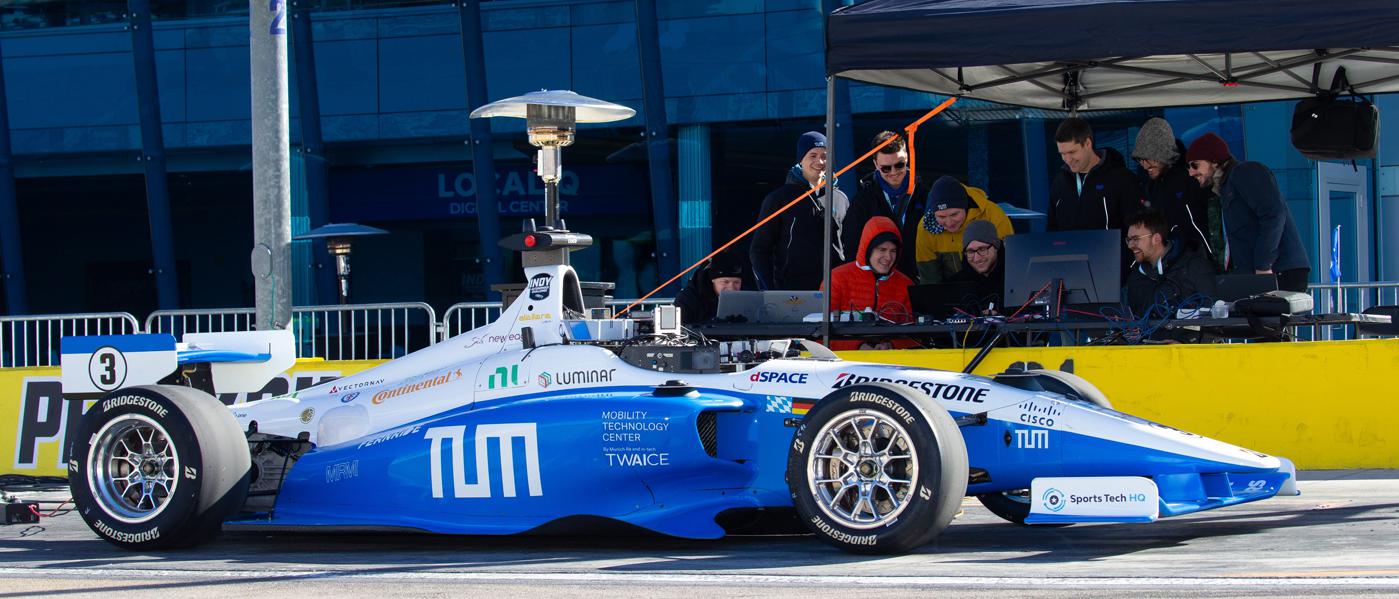
The drivers are written in code, but the racing competition is no less fierce.
Auto racing has long been a proving ground for technologies that expand the boundaries of the world around us. At the heart of the sport, however, has always been the competitive clash of driver against driver fueled by the desire to win, to vanquish opponents, to be the best no matter what the danger, and hoist the trophy.
So what is racing if the driver is not a human being, but rather software and sensors processing terabytes of data?
We’re about to find out, because autonomous racing is here and is making rapid advances around the globe. In the US, the Indy Autonomous Challenge (IAC), Indianapolis, Indiana, has been holding increasingly advanced autonomous races since 2021. The teams writing the code that pilot the cars come from top universities around the world, with backing by industry and governments.
“This is an applied research initiative that connects 18 of the top engineering universities around the world with top industry suppliers into the automotive sector. And that’s not just traditional automotive companies. Cisco is a partner,” explained Paul Mitchell, president of Indy Autonomous Challenge.
Governments have also taken an interest in the development of high-speed autonomy. The IAC receives backing from the state of Indiana and is on the federal government’s radar screen. “We had a lot of representation from the DoD [Department of Defense] and DARPA [Defense Advanced Research Projects Agency] at our event in Las Vegas. We have partnerships with some European countries—Italy, Germany—all working to use motorsport as a platform to accelerate the development of AI driver software and components that can handle high-speed ground-based autonomy,” Mitchell said.
Autonomous racing is far enough along that the IAC can brag of some impressive results. The cars are modified Indy Lights chassis built in collaboration with Dallara, although at the moment, the racing is not like an IndyCar event, where two-dozen cars compete on track at the same time. Nonetheless, the IAC achieved several milestones at the most recent event in January in Las Vegas as part of the Consumer Electronics Show (CES). At Las Vegas Motor Speedway, the IAC debuted its new AV-24 chassis, while its legacy AV-21 chassis achieved firsts in autonomous vehicles passing each other at speed.
“The race itself was the same format as the previous years: two cars at a time racing in these passing competitions on an oval. There was some really compelling action that took place, particularly in the semifinal round between Technical University of Munich, which went on to win the competition, and Korea Advanced Institute of Science and Technology,” Mitchell said. “It was really the first time we’ve seen in one of these races what you and I would describe as wheel-to-wheel racing through corners. Typically, our AI drivers, when they make a pass, they make a pass pretty directly—they accelerate, they go around the car, they move back into a race line once they’ve cleared it by a safe margin. If, for whatever reason, they aren’t able to make that pass, they usually back off.
“What happened was, the German team started a pass heading into Turn 1, and rather than completing the pass it ran wheel-to-wheel with the car from the Korean team through Turn 1, into Turn 2, and then made the pass. You and I would say, ‘Well, that’s racing.’ But we’d not seen that before with these fully autonomous AI drivers, which tells us that they’re getting better. We’re seeing an increase in the quality of the racing that appears more in line with top human race car drivers for IndyCar or for other series. That was, for me, the highlight of the race that took place at Las Vegas Motor Speedway on January 11.”
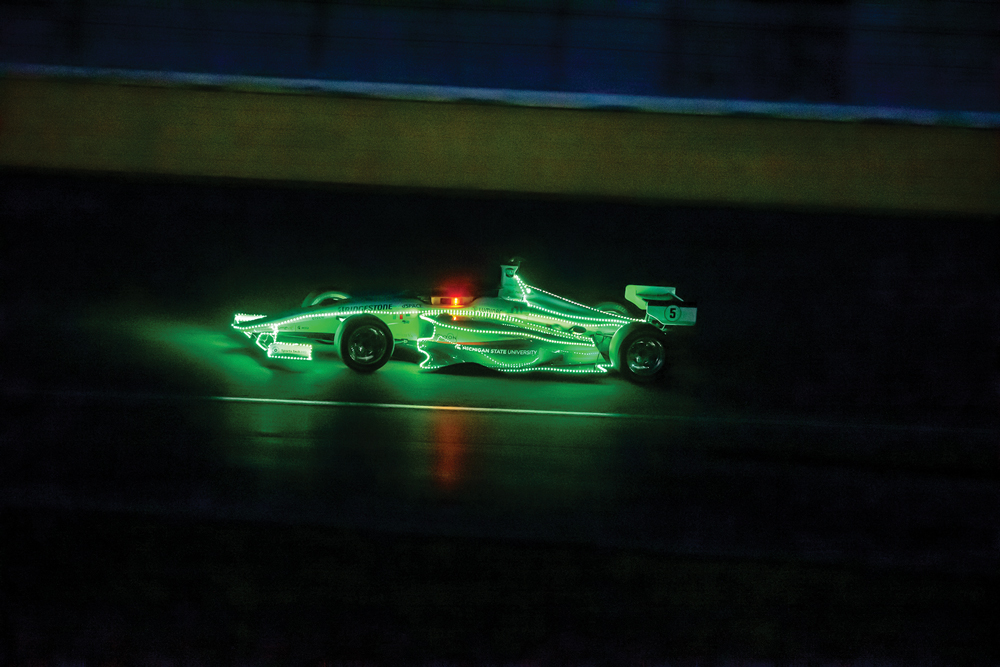
If the AV-21’s wheel-to-wheel passing seems unremarkable, the AV-24 car flexed abilities that humans would struggle to match. “The rollout of this new AV-24 vehicle was exciting because we put three cars on the track at the same time for the first time,” Mitchell explained. “We’ve never had three cars running together. And we had them running in the dark. The cars were lit up with LED lights but no headlights. The lights were turned off at the track. As the light came down to total darkness, the cars kept running. Then once it was completely dark, one of the cars passed another car.”
This type of research is part of a global competition to master autonomous technology. On the other side of the world, another series is set to hold its inaugural race on April 28, 2024, at the Yas Marina Circuit in Abu Dhabi, United Arab Emirates. The Abu Dhabi Autonomous Racing League (A2RL) uses customized Dallara Super Formula cars as the base competition vehicle.
For A2RL, the teams competing also represent an international collection of universities and institutions from the UAE, China, Germany, Italy, Singapore, Hungary, and the US.
“A2RL was conceived by ASPIRE, the technology transition pillar of Abu Dhabi’s Advanced Technology and Research Council,” said Stephane Timpano, CEO of ASPIRE. “A central motivation in establishing A2RL was to create an extreme testing ground to stress test and optimize the performance of autonomous vehicle software, enhancing safety and reliability. With its sophisticated infrastructure and technology focus, Abu Dhabi has become a hub for innovation. We are augmenting our knowledge economy through R&D, and A2RL just shows the scale of our ambitions for the future.
“Held once a year, the event will see competing teams partake in a series of races and challenges for a stake in the US $2.25-million prize purse, with engineers, scientists, programmers, and technicians becoming the ‘heroes’ of the sport.”
The Long View
Although racing is a high-profile testbed for autonomous technology, the ultimate goals reach far beyond the race track. “A2RL is certainly not intended to replace conventional motorsport or to develop systems that replace drivers in the future—absolutely not,” Timpano said. “It is an exciting proving ground for the world’s most advanced autonomous driving systems. We want to help accelerate the development and effectiveness of safe autonomous systems for road cars. At the same time, we hope that showing AI perform in such an extreme situation will build consumer confidence in everyday Advanced Driver Assistance Systems (ADAS) like Lane Assist or Automatic Emergency Braking, which some find disconcerting. We are doing science in public.”
A world dominated by autonomous technology will surely have drawbacks, but our autonomous racing sources reported plenty of upside. “The focus is, how do we get to a world where we have high-speed autonomy, cars and trucks that can move on highways at speeds greater than 100 mph, speeds that humans are not really well suited to pilot a vehicle,” Mitchell explained. “If we can get to that point, our economies will speed up from a supply chain standpoint, human mobility will speed up between destinations, and if it’s done in a way that’s safer, then even for humans driving at lower speeds on highways, think of how valuable that would be to society. That’s the long-term objective, that’s the North Star that everyone is working toward.
“Along the way we certainly hope to develop a way to transition some of these technologies and learnings into human-driven race cars to make them faster, safer, more effective,” Mitchell continued. “I often liken that to the modern US Air Force fighter jets. Think about the mechanical planes that were being flown in WWI and WWII, and how much the human had to do on their own, versus the F-35 today that at times can fly itself, but still very much relies on the capabilities of this extremely well-trained, almost superhuman, fighter pilot. I think that’s increasingly what our race car drivers are, and as we add more technology to the cars, adding technologies that can allow them to see 360 degrees, adding technologies that may give them separating front and rear braking, and other things, is all part of perhaps leading to higher performance, higher speed, and most importantly, safer motorsports.”
Team Sport
A conventional racing team will have a driver, crew chief, and pit crew, maybe a spotter or two, along with engine builders and engineers. Autonomous racing likewise requires a team, although the duties are divided in ways that reflect the technology involved.
CK Wolfe is the program manager for Research Operations and Technical Projects at the University of California, Berkeley. AI Racing Tech is the name of the Berkeley autonomous racing team, a collaboration between UC Berkeley, University of Hawai’i (UH), University of California, San Diego (UCSD), and Carnegie Mellon University. AI Racing Tech was one of the three teams testing the AV-24 at Las Vegas, with Wolfe as the simulation team lead.
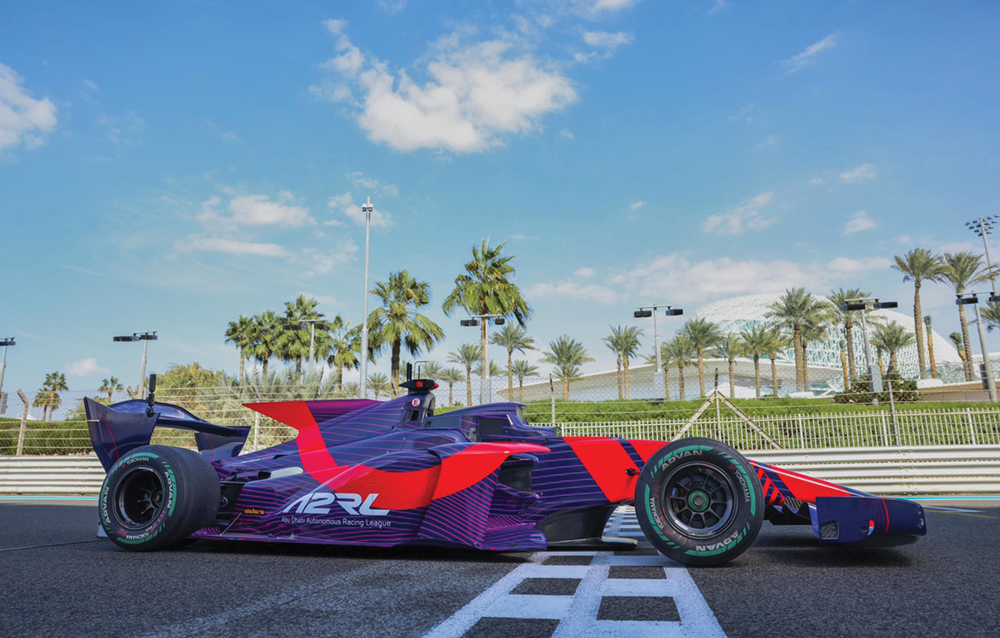
“The sub-teams that we have are perception, planning, localization, controls, vehicle dynamics, simulation, and trackside logistics,” Wolfe said. “The trackside logistics is like our pit crew that a normal racing team would have. On the autonomy side, because we write software to make all of the same decisions in real-time that a real race car driver would have to do, you have to respond to the track conditions. The top 1% of drivers in the world are the ones who actually end up in the racing field, and we’re trying to mimic what they do.
“So you need your race car to be able to respond to the changes on the track, to be able to sense those things, and make decisions in real-time the same way that an actual race car driver would. There are a lot of components of that,” she continued. “Perception is how you see the world. High-level planning is, based on what you see in the world, how you’re making those decisions. Controls would be how you’re executing those decisions, like how you’re actuating the low-level steering, throttle, brake commands, which can be a very complicated way to apply things. Vehicle dynamics is how you’re modeling the car. Simulation, which is the team I lead, brings all of those things together, and you’re driving the car in simulation the same way you would in the real world, to try to validate all of that software and all of that AI for the real car before we even get to the track.”
High-speed autonomy requires the race car to be equipped with a suite of leading-edge processors and sensors, and the IAC’s new AV-24 chassis employs the best of the best.
“For perception we added more capabilities by putting some rear-facing sensors. There’s a lidar that’s facing backward and a radar that’s facing backward,” the IAC’s Mitchell said. “In the AV-21 there’s nothing facing backward. So we created 360-degree uninterrupted lidar perception by having four lidars instead of three on the car.
“Additionally, we’ve upgraded the quality of the sensors. We went from a first-generation lidar from our sponsor Luminar to its newest one called the Luminar Iris, which is longer range, more accurate, and more powerful. Similarly, for radar we changed from a legacy radar technology to a brand-new Continental 4D radar, a more advanced radar technology. And then we’ve increased the 360-degree perception of our cameras.
“For localization, we added more GPS, GNSS [global navigation satellite system] capabilities—stronger, better, more accurate GPS. We also increased the wireless communication pathways because another way you do localization is not just by GPS, but communicating with race control so we understand where the cars are. For that we added this Marelli telemetry device that is used in F1.
“In vehicle dynamics, we made some really big changes by putting in a completely new drive-by-wire system, steering and braking,” Mitchell continued. “We actually did it as an internal engineering project within IAC, sourcing rotary actuators and linear actuators that are very robust, accurate and fast, and could handle the harsh operating conditions of a race car. So we dramatically improved the steering strength and accuracy. For braking, with two linear actuators, we separated the braking of the front master cylinder and the rear master cylinder, so the AI driver can send different brake pressures to the front and rear of the car.”
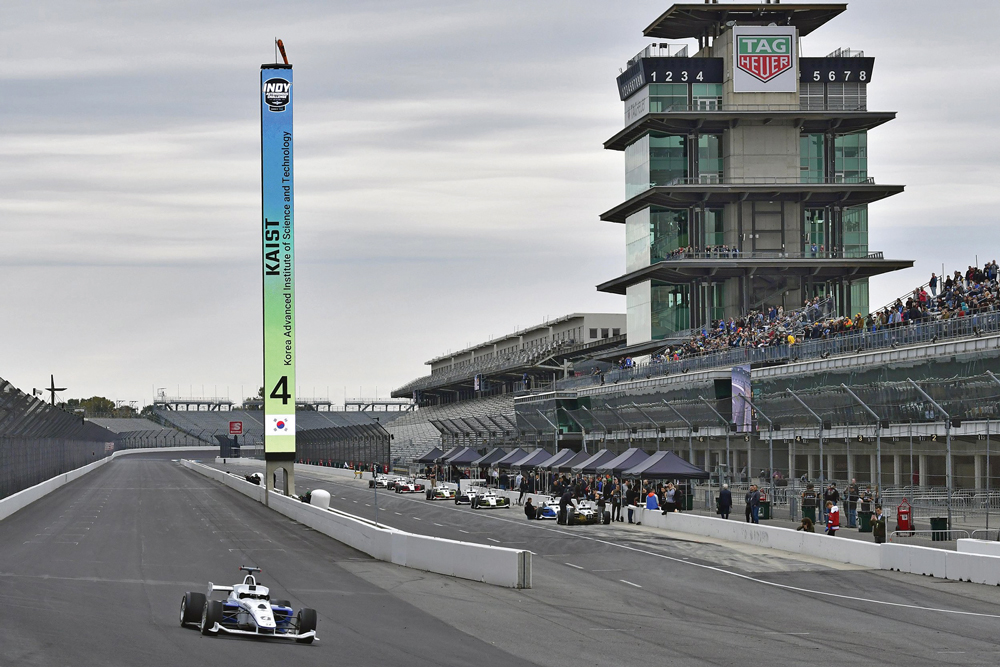
This hardware and software magic can take a race car quite far, but it still helps to have the perspective of a racing veteran to speed things along. One such veteran is Gary Passon, who currently runs the AVT program at the University of Hawai’i and is the AI motorsports team principal. As a driver, he progressed through the amateur and semi-professional ranks, rising as high as the USAC Mini-Indy series (today’s Indy NXT) before leaving racing behind to focus on a career in the computer industry. “I retired after 30 years of industry work and moved to Maui, and got involved again in technology, but this time blending my computer background with my racing background by involving the University of Hawai’i in autonomous vehicle technologies,” Passon said.
“In the beginning it was all about just getting the car to move and getting it to go around the track without hitting something. And then pretty soon you want to do that a little faster, and a little faster, and that’s kind of what a new driver coming up in racing goes through,” Passon said. “They have to earn their way into the program by learning the nuances of operating at the extreme of the tires and the vehicles themselves. What I hopefully have helped bring to the table is the perspective and experience from having done that as a human, and trying to highlight for the team the areas where we need to put our focus so that we can teach our autonomous driver the way of the world and the limits in which it has to operate and go there in a safe and fast manner. Crashing cars is not good whether it’s a human or an AI driver.”
Real Deal
Autonomous racing is so new on the scene that misconceptions still pop up. These are not race cars being guided remotely or piloted using a racing simulator. “We’re talking about full level 5 autonomy, meaning that the moment that the competition starts, other than turning the car on, the team does nothing,” Mitchell said. “They’re sitting there and they’re watching. The only thing they can do is they have essentially the ability to abort if they see something on their telemetry data or their vehicle’s behavior that they don’t like.”
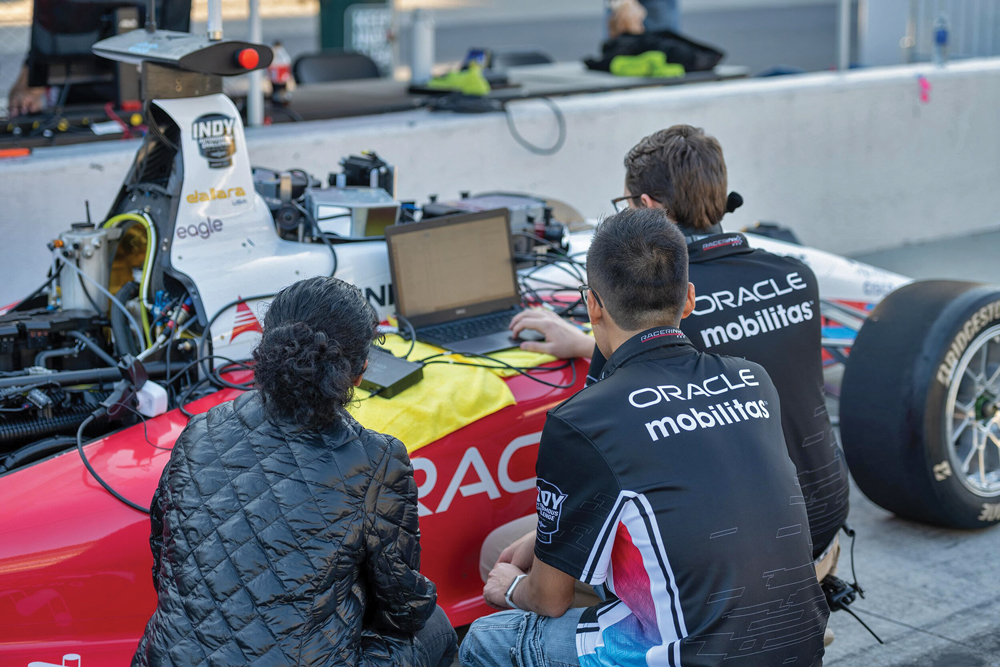
“I feel like there’s a lot of confusion for people, where they seem to think that autonomy means something like a giant RC car, and they don’t see the point,” Wolfe said. “Which I think is a little unfortunate. If I were to try to communicate one thing, it’s that the level of complexity that goes into engineering an autonomous system, essentially something that responds in real-time and can react and mimic the behavior and precision of the top 1% drivers in the world, is not a trivial task.
“Autonomy is still a huge research area in industry and in academia, and in many ways, it is still an unsolved problem. What we’re doing when we engineer these systems is, we’re writing code that can make decisions in real time and execute those decisions and compete in an adversarial head-to-head competition while we do nothing. So we have to write software that is intelligent enough to mimic all of those human behaviors in real time and make those decisions and optimize and try to race to win,” she said.
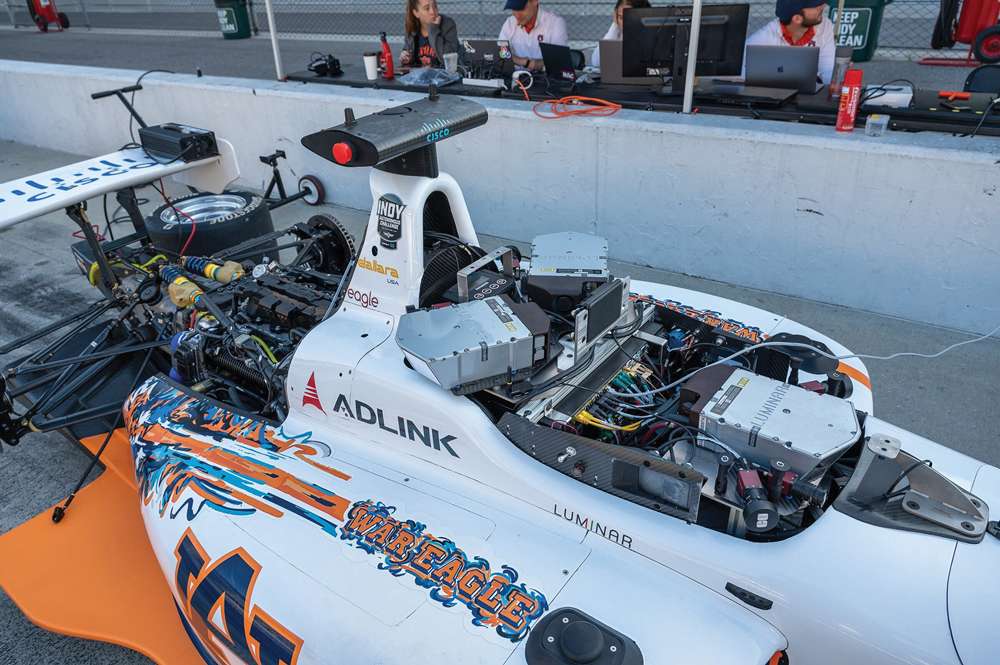
Autonomous vehicle technology will advance, but racers shouldn’t worry about losing their seats to some future hard-driving Terminator, according to our sources.
“A lot of people think what we’re doing is creating some kind of future motorsports thing that replaces human drivers and the kind of motorsports that most people are used to. I think that’s probably a misperception,” Passon said. “Yes, I think autonomous racing is here to stay. I don’t think that’s going to go away. It’s going to get more and more competitive, and it’s going to get more and more visibility. But I don’t think it’s a replacement for traditional human-driven motorsport. I think it’s a complement to that.”
Autonomous Racing Calendar
Abu Dhabi Autonomous Racing League 2024
• Yas Marina Circuit in Abu Dhabi April 28
Indy Autonomous Challenge 2024
• Milan Monza Motor Show, Autodromo Nazionale Monza June 28–30
• Goodwood Festival of Speed July 11–14
• Indianapolis Motor Speedway September 6
SOURCES
Abu Dhabi Autonomous Racing League (A2RL)
a2rl.io
AI Racing Tech
airacingtech.com
Indy Autonomous Challenge
indyautonomouschallenge.com
 MEMBERSHIP LOGIN
MEMBERSHIP LOGIN JOIN PRI
JOIN PRI


